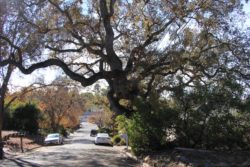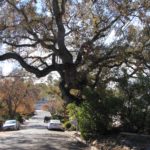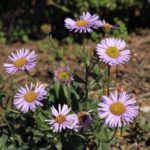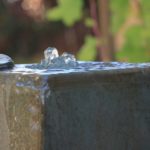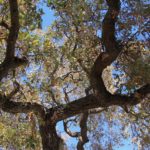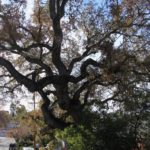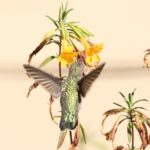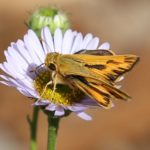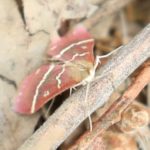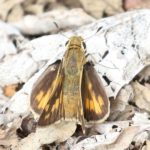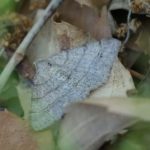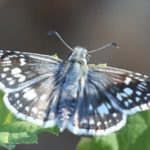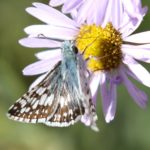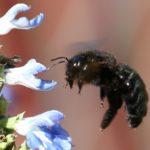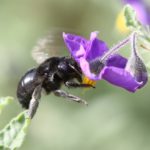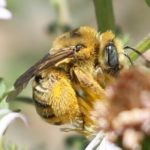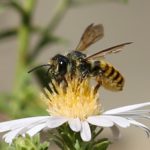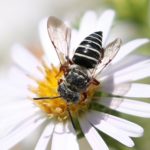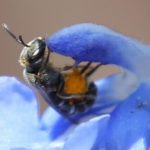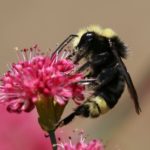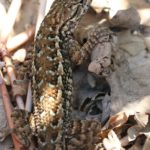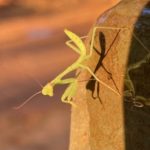Lot size: 900 sq. ft. front garden, 2,000 sq. ft. side and back garden, 95% native
Garden Age: Garden was planted in October of 2022
Years on the Bringing Back the Natives Garden Tour: New this year!
Showcase Feature
The lawn wasn’t cutting the mustard for Save Mount Diablo conservation biologist Juan Pablo, whose goal was to create a garden that would attract birds, butterflies, and native bees.
The stage for the garden of his dreams was set by the magnificent valley oaks that grace the front and back gardens, reminiscent of the time—not so very long ago—when enormous herds of tule elk and antelope roamed nearby hillsides and valleys covered with wildflowers and bunchgrasses, and drank from streams teeming with migrating salmon, as condors with nine-foot wingspans soared overhead.
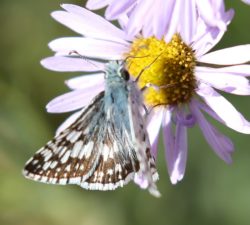 This wildlife-attracting garden was designed by Kelly Marshall of Kelly Marshall Garden design free-of-charge, through the Contra Costa Water District’s Landscape Design Assistance Program, and Juan Pablo received a $750 rebate from the District through its Lawn to Garden program for replacing the lawn with natives. Juan Pablo sheet mulched the lawn away; the plants were planted and the irrigation system was installed by Juan Pablo and friends.
This wildlife-attracting garden was designed by Kelly Marshall of Kelly Marshall Garden design free-of-charge, through the Contra Costa Water District’s Landscape Design Assistance Program, and Juan Pablo received a $750 rebate from the District through its Lawn to Garden program for replacing the lawn with natives. Juan Pablo sheet mulched the lawn away; the plants were planted and the irrigation system was installed by Juan Pablo and friends.
Perennials such as California lilac, manzanitas, buckwheat, and sages anchor the garden, providing greenery and stability throughout the year. Seasonal color is provided by the masses of bright yellow flowers on goldenrod, lovely blossoms of the purple bush lupine, striking red tubular flowers on the California fuchsia, and the cheerful lavender summer-through-fall blooms of the aster.
Other Garden Attractions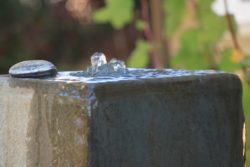
• Juan Pablo works for the land trust and conservation organization Save Mount Diablo, as does Antioch garden tour host Laura Kindsvater; information on Save Mount Diablo will be available at their gardens.
• Landscape designer Kelly Marshall, owner of Kelly Marshall Garden Design, will be on hand all day to answer your questions!
Gardening for Wildlife
The plants in this garden were selected to attract birds, native bees, and butterflies—and they have really done the job! You can see photos of the more than seventy species of wildlife photographed in Juan Pablo’s (still new) garden on his iNaturalist page.
In addition to the terrific selection of native plants, the venerable oaks, burbling pillar fountain and bird bath have attracted nearly thirty species of birds, including Downy, Nuttall’s, and hairy woodpeckers, sharp-shinned, Cooper’s and red-tailed hawks, barn and great horned owls, northern flickers, and cedar waxwings.
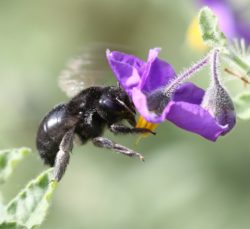 This bee-friendly garden contains plants that flower at different times of the year and provide pollen and nectar for bees both big and small. Research has shown that—not surprisingly—native bees prefer native plants over plants from the Mediterranean, Australia, and South Africa. Juan Pablo has seen fourteen species of native bees in his garden, including yellow-faced and black-tailed bumble bees, and leafcutter, golden-haired miner, mason, digger, and sweat bees. Recently, he was delighted to discover that a newly mated queen black-tailed bumblebee was overwintering in a small nest in a dry part of the garden. He noticed that, to keep herself safe in her tiny home, the opening was covered by leaf litter (remember, leave the leaves!). In spring she
This bee-friendly garden contains plants that flower at different times of the year and provide pollen and nectar for bees both big and small. Research has shown that—not surprisingly—native bees prefer native plants over plants from the Mediterranean, Australia, and South Africa. Juan Pablo has seen fourteen species of native bees in his garden, including yellow-faced and black-tailed bumble bees, and leafcutter, golden-haired miner, mason, digger, and sweat bees. Recently, he was delighted to discover that a newly mated queen black-tailed bumblebee was overwintering in a small nest in a dry part of the garden. He noticed that, to keep herself safe in her tiny home, the opening was covered by leaf litter (remember, leave the leaves!). In spring she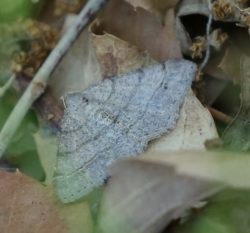 will emerge from her snug nest, and enjoy nectar from the plants in this garden—the first food she will had had for many months—before collecting pollen with which she will make her nest.
will emerge from her snug nest, and enjoy nectar from the plants in this garden—the first food she will had had for many months—before collecting pollen with which she will make her nest.
As the juvenile stages of butterflies and moths often spend the winter in leaf litter, leaves are left on the ground (where they also help improve the soil). Eleven species of butterflies and moths flutter about the garden, including monarch, gray hairstreak, and mournful duskywing butterflies; common checkered, umber, and fiery skippers; and mint moths.
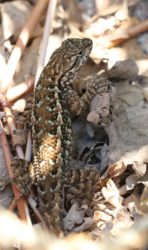 Boulders, originally brought in to discourage free-roaming chickens from scratching out the plants, have attracted Western fence lizards, which bask on and shelter between the rocks. Brush piles provide additional safe spaces in which wildlife can shelter.
Boulders, originally brought in to discourage free-roaming chickens from scratching out the plants, have attracted Western fence lizards, which bask on and shelter between the rocks. Brush piles provide additional safe spaces in which wildlife can shelter.
Garden Talks
12:00 and 2:00 “How I started and maintain my native plant wildlife habitat garden” by
Juan Pablo Galván Martínez
Keystone species (watch this talk by Doug Tallamy!)
Keystone species—our own, local ecological powerhouse plants—in this garden include oak, hollyleaf cherry, California lilac, currant, manzanita, lupine, aster, goldenrod, sage, buckwheat, and penstemon.
Green Home Features
Juan Pablo drives an electric vehicle, and cooks on an induction stovetop.
At least partially wheelchair accessible? Yes.


